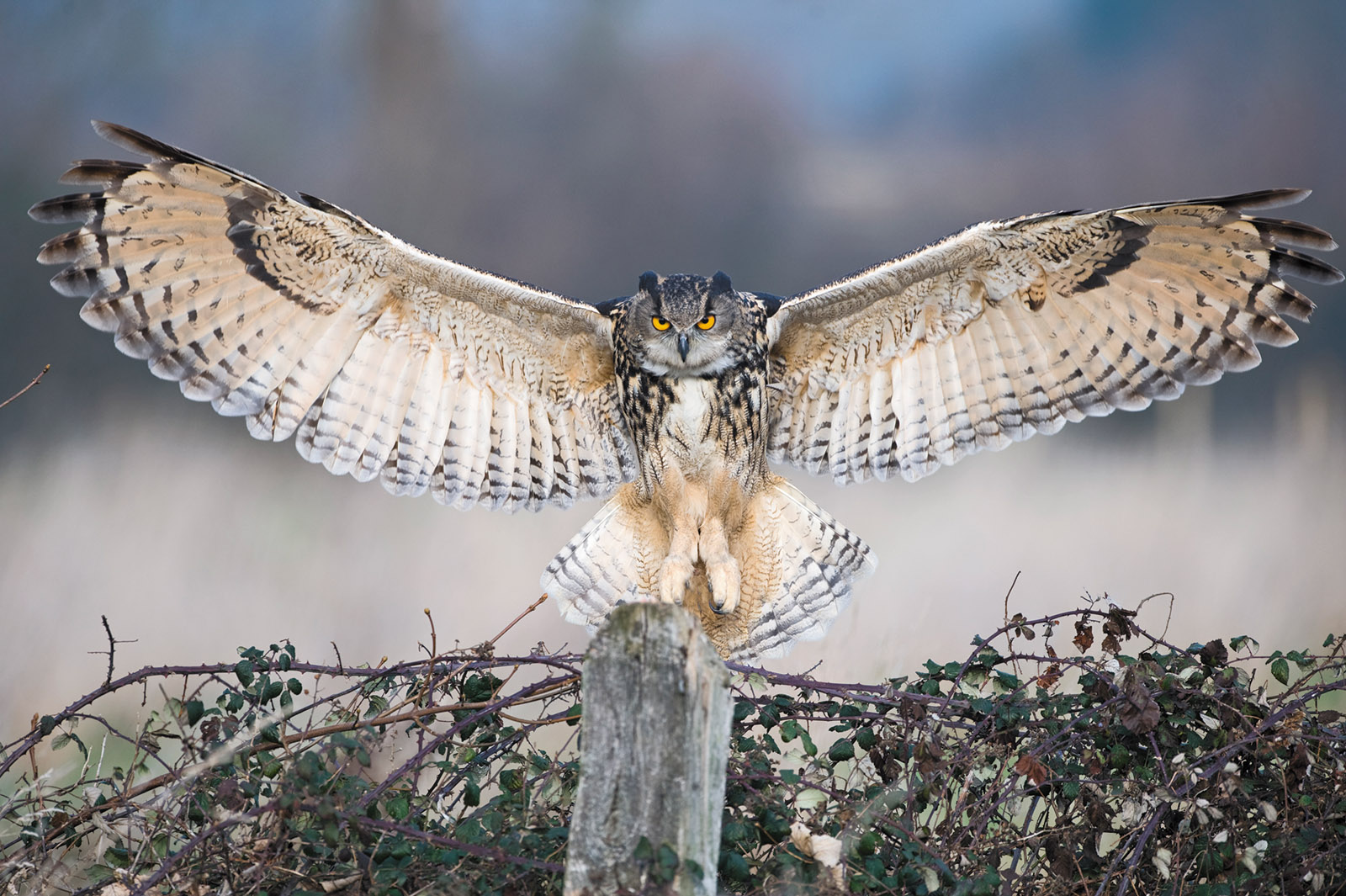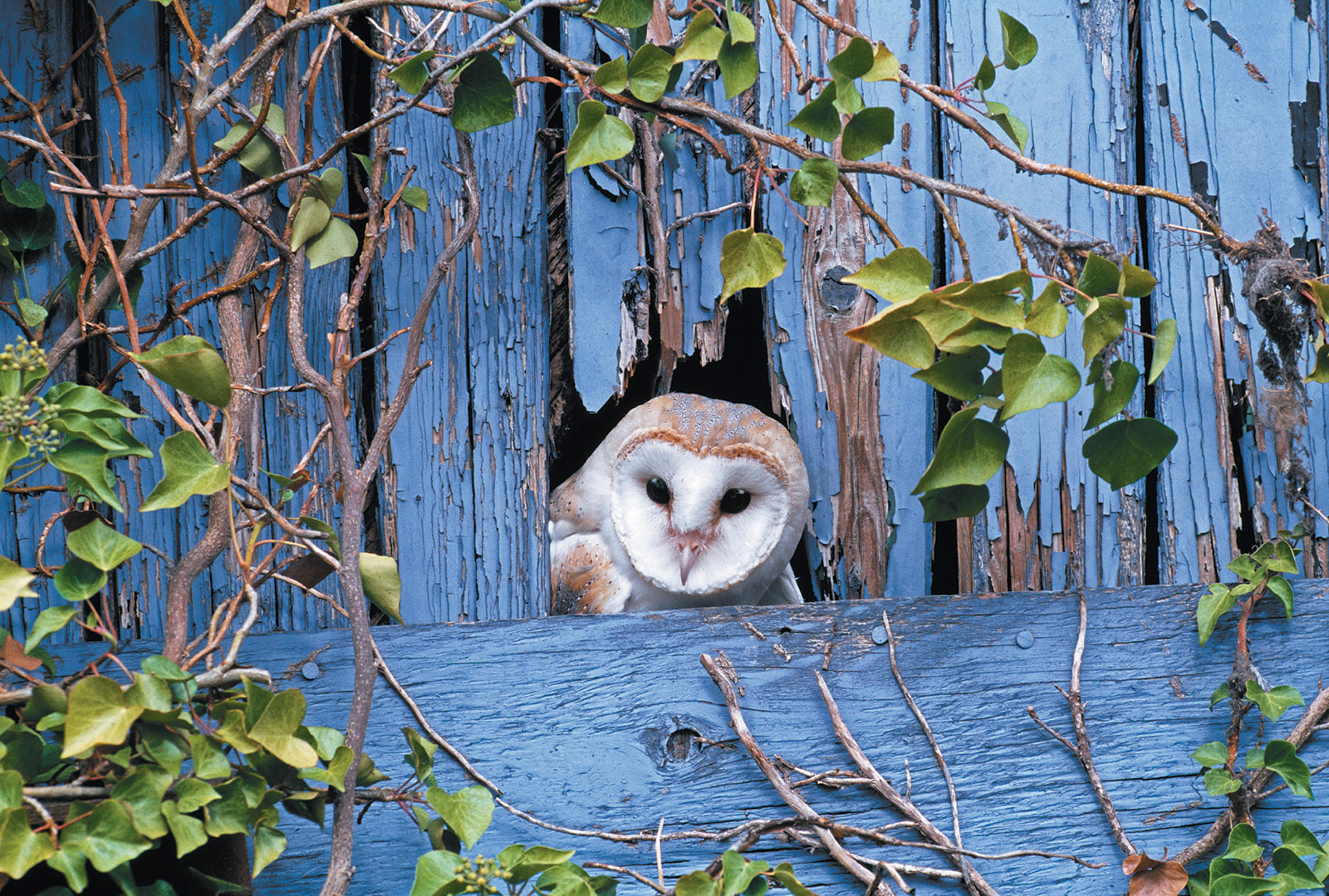Humans have always noticed owls. One of the earliest examples of Paleolithic art is an owl engraved on the wall of the Chauvet cave in France.1 Among the peculiarities of owl physiognomy is that owls have both eyes facing forward, unlike most birds. They can also turn their heads 270 degrees (making up for their inability to move their eyes). It has been easy to imagine that these creatures of darkness, mostly experienced as an ominous cry in the night or a disconcerting stare during the day, have personalities, and malign ones at that. Even today, the two books under review tell us, in many parts of the world owls are killed whenever they are encountered, for fear of their evil influence.
The Greeks perceived owls more positively, as embodiments of wisdom. The “owl of Athena” portrayed on Athenian coinage represents a real species, the little owl (Athene noctua), which can still be seen among Mediterranean ruins. Nowadays Europeans and Americans generally regard owls as benign but sometimes as pretentious, as in The Stuffed Owl: An Anthology of Bad Verse, which famously mocks poetry of “sentimentality” and “banality,”2 or the pompous know-it-all in A.A. Milne’s Winnie-the-Pooh who misspells his own name “Wol.”
The truth about owls is less fantastical but no less interesting than what humans project onto them. Owls’ remarkable physical attributes were shaped by the imperatives of the hunt. They are impressive killing machines, capable of dispatching other birds or animals larger than themselves. Central to this are big legs and claws, wing feathers designed for silent flight, and highly sensitive eyes and ears. Owls have acute binocular vision and, contrary to legend, can see in daylight.
Hearing is even more important to owls than seeing. Their ears make it possible for them to locate prey in total darkness. In some owls, one ear is larger than the other and located higher on the head, so they can locate rustling mice by aural triangulation. Some of the photographs in The Enigma of the Owl by Mike Unwin and David Tipling show arctic species, such as the great grey owl, diving deep into snow to capture rodents that they have located entirely by sound. The ear-like tufts on some owls’ heads have nothing to do with this superb hearing system, which is covered by feathers. The tufts probably evolved as a device for camouflage in daylight.
There are over two hundred species of owls, but the exact number keeps changing. Therefore Marianne Taylor’s rash promise to portray “every species in the world” is impossible to keep. On the one hand, vulnerable species are going extinct. The laughing owl of New Zealand disappeared at least fifty years ago, and more tropical species are likely to follow it into oblivion as forests are cleared for palm oil plantations or other agricultural purposes. The Pernambuco pygmy-owl, native to the nearly vanished primary rainforests of northeastern Brazil, has not been seen since 2004, Taylor tells us. The many species limited to a single island in Indonesia or the Philippines are vulnerable not only to deforestation but also to invasive predators such as rats, snakes, and ants. Still others may turn out on closer study to be merely local variants of a single species.
On the other hand, new species of owls are being discovered. A few have been found the old-fashioned way, by hard slogging in remote places. In September 1976, John P. O’Neill and Gary Graves, researchers from Louisiana State University, were studying the birds of an unexplored stretch of dense cloud forest high in the northern Peruvian Andes. They were preparing to strike camp after three unsuccessful days in the rain when a tiny owl turned up in one of their nets. They had never seen anything like it. They named it the long-whiskered owlet for its strange facial bristles. It was so unlike any other owl that it was placed in a new genus all to itself, Xenoglaux, whose name is derived from the Greek words for “strange owl.” Additional long-whiskered owls weren’t found until 2007. Since then, an ecotourism business has grown around a reliable location where birders who want to see this bizarre creature can stay in a comfortable lodge.
Scientific research has revealed far more new species of owls than has exploration. When cheap, reliable, portable digital recording devices replaced cumbersome tape recorders in the 1990s, it became much easier to capture an owl’s vocalizations. Many more owls could then be found and studied. Owls are intensely territorial, and when a male hears a rival male of the same species invade his territory, he attacks. By posing as an intruder, an observer equipped with speakers can quickly bring an aggrieved male into view. These techniques have increased our knowledge of the number and distribution of many species of owls.
Advertisement
Sound recording also upended traditional owl classification. Before recording, owls that looked alike were assumed to belong to the same species. However, analysis of owl calls showed that similar-looking owls could sound different. Taxonomists today define as a species a population that is isolated reproductively, rather than, as before, a population of similar appearance. Since a female owl will not mate with a male unless he gives the right vocal cues, sound functions as an effective isolating mechanism. Now a population with a distinctive vocal repertoire is considered a separate species, even if there is little distinctive about its physical appearance. When Taylor’s book gets to the smaller owls—the pygmy-owls, scops-owls, and screech-owls—it shows picture after picture of birds that look nearly identical but are, we are told, distinguished by sound. It would be interesting to have an audio book that lets us hear what gives each species its particular identity.
Owl taxonomy has been further revised by examination of DNA. Owl populations that look like others but are isolated reproductively are likely also to differ genetically. Geography can isolate a population as well as vocalization, and many of the new look-alike species are limited to one of the many small islands in the Indian Ocean and the Indonesian Archipelago. Although DNA analysis is much more expensive and cumbersome than digital recording, some of the new species portrayed in Taylor’s book have been identified by this method. Genetic analysis and sound recording have greatly expanded the owl family tree in just a couple of decades.
Taylor makes a gallant effort to be up-to-date on owl taxonomy and nomenclature despite their ongoing flux. She covers 225 species, but there is no agreement about the precise number of owl species in existence or, indeed, about which ones are authentic species. The first edition of Owls: A Guide to Owls of the World by Claus König, Jan-Hendrick Becking, and Friedhelm Weick, published in 1999, treated 227 species. The number grew to 250 in their second edition, published ten years later. Another authoritative work, Handbook of the Birds of the World, covered 205 species of owls in its fifth volume, but many more have been split from other species (at least for the moment) since it appeared in 1999. The Handbook contains photos of owls in action as exciting as those in The Enigma of the Owl.
The enigma referred to in Unwin and Tipling’s title is mostly simple ignorance. We know almost nothing about many of these putative new species, since they inhabit deep tropical forests or remote islands. Taylor found no suitable picture of twenty of them. Some of these newly described species may well be extinct before we know how they live (while others may be downgraded to subspecies).
North American owls have naturally been much more thoroughly studied than tropical ones. Even New York City has its owls. Gigantic great horned owls, larger than all New World owls except the Snowy Owl, have nested for years in Pelham Bay Park in the Bronx. Barn owls used to nest widely in empty buildings and abandoned water tanks in New York City, and some still use boxes provided for them at the Jamaica Bay Wildlife Refuge, adjacent to JFK Airport. During cold weather some northern species fly south to spend the winter in New York City parks: long-eared owls, saw-whet owls, and, once, a boreal owl. When one of these northern owls turns up in Central Park, the birders try to keep its sleeping spot secret from photographers who crowd ever closer in an understandable desire for the perfect shot. These skirmishes between birders and photographers come close to physical combat when the snowy owl—described by Unwin and Tipling as “not only the world’s most unmistakable owl, but also one of its most impressive birds”—comes south in the winter and finds an equivalent of its native tundra on outer Long Island beaches.
Some owls have accommodated themselves very well to human settlements. Those whose natural habitat is varied open terrain are more likely to live in towns and cities than owls of tropical forests. Screech owls are surprisingly abundant in American suburbia. The 2010 Christmas Bird Count in leafy Upper Bucks County, Pennsylvania, found 237 of them within a circle fifteen miles across. One of the largest owls in the world, the Eurasian eagle owl, is increasingly found in densely populated Western Europe and, since it doesn’t fear humans, nests in quarries and cliffs in the well-populated countryside. The tawny owl, Shakespeare’s “tu-whit, tu whoo,” comes into European city parks. I once saw one of these midsized owls fly overhead in the center of Paris, briefly illuminated by a streetlight. There are plenty of rodents and small birds for owls to eat in modern cities if they don’t mind human company.
Advertisement
Fragile owl species, by contrast, struggle to survive the transformation of their natural habitats. The little owl of Athena has become much rarer around the Mediterranean, probably because the widespread use of insecticides has eliminated many of the large insects it eats. The danger is greatest for highly specialized species that require unbroken forest or extensive marshes to survive. Some of these populations have been reduced to a critically small number.
One curious case is that of the forest owlet, now known to persist in a few remnants of forest in central India. Forest owlets were discovered in the 1880s by British colonial administrators (many of whom were amateur ornithologists). Then these birds went undetected for 113 years. One reason was that later ornithologists looked for the bird at the location where a specimen in the British Museum, dated 1914, was allegedly found by Colonel Richard Meinertzhagen, a particularly avid British colonial administrator and ornithologist. (As chief of intelligence in Egypt during World War I, he was the commanding officer of T.E. Lawrence.) Then it was discovered that Meinertzhagen had the unpleasant habit of stealing skins of particularly rare birds from the British Museum and relabeling them with his own fictitious date and place to enhance his ornithological reputation. In 1997, Pamela Rasmussen and Ben King went back to the location of the earliest specimens and found a surviving forest owlet.
Since owls have the night pretty much to themselves, as far as birds are concerned, they have evolved into a wide variety of shapes, sizes, and behaviors. Color is their least variable aspect. They come mostly in cryptic browns and greys, since their plumage matters less for courtship than for concealment. Their courtship, conducted mostly in the dark, is primarily vocal. But owl size ranges from the enormous eagle owls to the tiny sparrow-sized elf owl of Arizona.
Owl diets vary with size and habitat. While smaller owls eat insects and little birds, larger ones can handle midsized mammals. Great horned owls’ nests are said to smell often of skunk. A few owls are adapted to catching fish. One of these, the Blakiston’s fish-owl, is among the world’s largest. My wife and I were once taken to a restaurant on the northern Japanese island of Hokkaido where the main attraction was not the sushi (about which I remember little) but the unforgettable nightly visit of an enormous Blakiston’s fish-owl that came to a small stream just outside the window to feed. The restaurant owner, I suspect, put out some extra fish.
Owls also vary in the extent of their geographic ranges. Taylor’s maps are very helpful and have few errors (though burrowing owls are shown living much too far northeast). Some owls are found nearly worldwide—the barn owl, for example. At the other extreme, some, like Xenoglaux, are limited to a few ridges in the Peruvian Andes.
Efforts to protect one species of North American owl became an issue in the 1992 presidential election. President George H.W. Bush warned that if environmentalists like vice-presidential candidate Al Gore got their way, “we’ll be up to our necks in owls and outta work for every American.” The owl in question was the spotted owl, a midsized forest owl of the Pacific Northwest that disappears when old-growth forest is cut. Efforts to preserve old-growth forest for the bird infuriated workers in the declining lumber industry. They sported bumper stickers that read “shoot an owl, save a logger.” The issue has now subsided, mostly because the loggers, having lost the “spotted owl war,” found other work or other homes.
Today the few spotted owls that remain in the United States (they are nearly gone from Canada) have a new enemy. The closely related but more aggressive barred owl, abundant in the eastern United States, is expanding into the Pacific Northwest, where it pushes out the slightly smaller spotted owl. The US Forest Service has been discreetly culling barred owls in that region. Even so, the spotted owl could become the first North American owl to go extinct.
Behavior of owls also varies widely. Burrowing owls live in underground tunnels in open country, such as prairie dog burrows, and are active by day. Many species of pygmy-owl are also diurnal, as is the snowy owl, since it nests at a latitude where the sun never sets in summer.
Not surprisingly, hundreds of books have been devoted to owls. According to biologist Bernd Heinrich, who reared a foundling great horned owl, a new book about owls appears just about every year. “The general biology of owls,” he wrote, “may already have received more exposure than that of any other bird.”3
Even so, both of these new books have something to offer. Taylor’s Owls is the more encyclopedic, offering condensed information about a plausible version of all the world’s species of owls. Unwin and Tipling in The Enigma of the Owl select fifty-three notable species, arranged geographically, and write agreeably and extensively about them. The photographs of owls in their book are more evocative than Taylor’s pictures, the bulk of which constitute a long portrait gallery, one for each species. These can appear artificially posed, since the backgrounds have been digitally altered to a neutral color. The plains-dwelling burrowing owl appears on a highly unlikely lichen-covered forest branch. None of the authors is a professional biologist, and although they have clearly worked hard and are generally knowledgeable, serious students of owls may want to consult Owls of the World and Handbook of the Birds of the World.
-
1
See Andrew J. Lawson, Painted Caves: Paleolithic Rock Art in Western Europe (Oxford University Press, 2012), p. 312. It can also be seen at www.bradshawfoundation.com/chauvet/owl.php. ↩
-
2
Selected and arranged by D.B. Wyndham Lewis and Charles Lee (1930; New York Review Books, 2003). ↩
-
3
Bernd Heinrich, One Man’s Owl (Princeton University Press, 1987), p. 193. ↩





